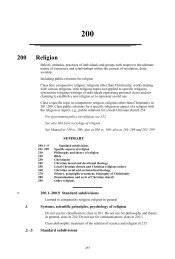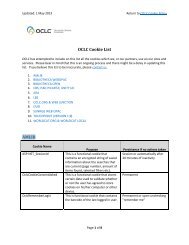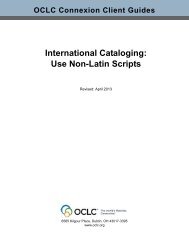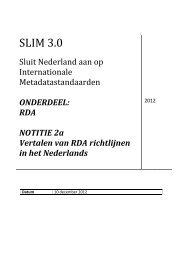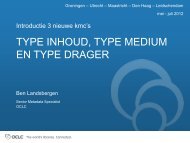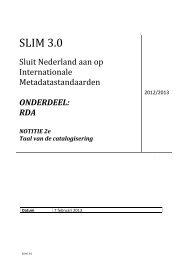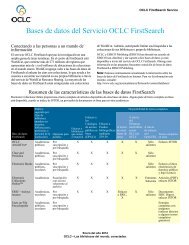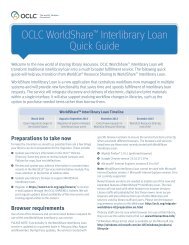4. Character Sets - OCLC
4. Character Sets - OCLC
4. Character Sets - OCLC
You also want an ePaper? Increase the reach of your titles
YUMPU automatically turns print PDFs into web optimized ePapers that Google loves.
<strong>4.</strong>2 Non-Latin Script <strong>Character</strong> Set (continued)<br />
Field 880 (continued)<br />
Subfield ‡6<br />
Examples:<br />
245 10‡6880-02‡aHung Jen-kan /‡ccShen Wei-pin chu.<br />
880 10‡6245-02/‡1‡a[Chinese characters]<br />
260 ##‡6880-12‡aMoskva : ‡bIzd-vo "Nauka",‡c1982.<br />
880 ##‡6260-12/(N‡a[Cyrillic characters] : ‡b[Cyrillic characters]<br />
"[Cyrillic characters]", ‡c1982.<br />
880 2#‡6110-01/(2/r‡a[Heading in Hebrew script linked to associated field]<br />
880 ##‡6530-00/(2/r‡a[Additional physical form available information in<br />
Hebrew script]<br />
880 1#‡6100-01/(N‡a[Heading in Cyrillic script]<br />
880 ##‡6260-02/(2/r‡a[Tel Aviv] : ‡b)[Hebrew characters] ‡c[1985]<br />
Each 880 field is linked via subfield ‡6 (Linkage) to a bibliographic description<br />
field. Field 880 always contains subfield ‡6 as the first subfield. Many bibliographic<br />
description fields also contain subfield ‡6, also appearing as the first subfield.<br />
Data that links fields that are different script representations of each other. Subfield<br />
‡6 may contain the tag number of an associated field, an occurrence number, a code<br />
that identifies the first script encountered in a left-to-right scan of the field, and an<br />
indication that the orientation for a display of the field data is right-to-left. A regular<br />
(non-880) field may be linked to one or more 880 fields that all contain different<br />
script representations of the same data.<br />
Subfield ‡6 is structured as follows:<br />
‡6 [linking tag]-[occurrence number]/[script identification code]/ [field orientation<br />
code]<br />
The linking tag part contains the tag number of the associated field. This part is<br />
followed immediately by a hyphen and the two-digit occurrence number part. A<br />
different occurrence number is assigned to each set of associated fields within a<br />
single record. The function of an occurrence number is to permit the matching of the<br />
associated fields (not to sequence the fields within the record). An occurrence number<br />
may be assigned at random for each set of associated fields. An occurrence number<br />
of less than two digits is right justified and the unused position contains a zero.<br />
Examples:<br />
100 1#‡6880-01‡a[Heading in Latin script]<br />
880 1#‡6100-01/(N‡a[Heading in Cyrillic script]<br />
245 10‡6880-03‡aSosei to kako : ‡bNihon Sosei Kako Gakkai shi.<br />
880 10‡6245-03/‡1‡a[Title in Japanese script] : ‡b[Subtitle on Japanese script]<br />
[Primary script is Latin; alternate script is Japanese]<br />
100 1#‡6880-01‡a[Name in Chinese script]<br />
880 1#‡6100-01/(B‡aShen, Wei-pin<br />
[Primary script is Chinese; alternate script is Latin]<br />
4:12 <strong>OCLC</strong>-MARC Records




